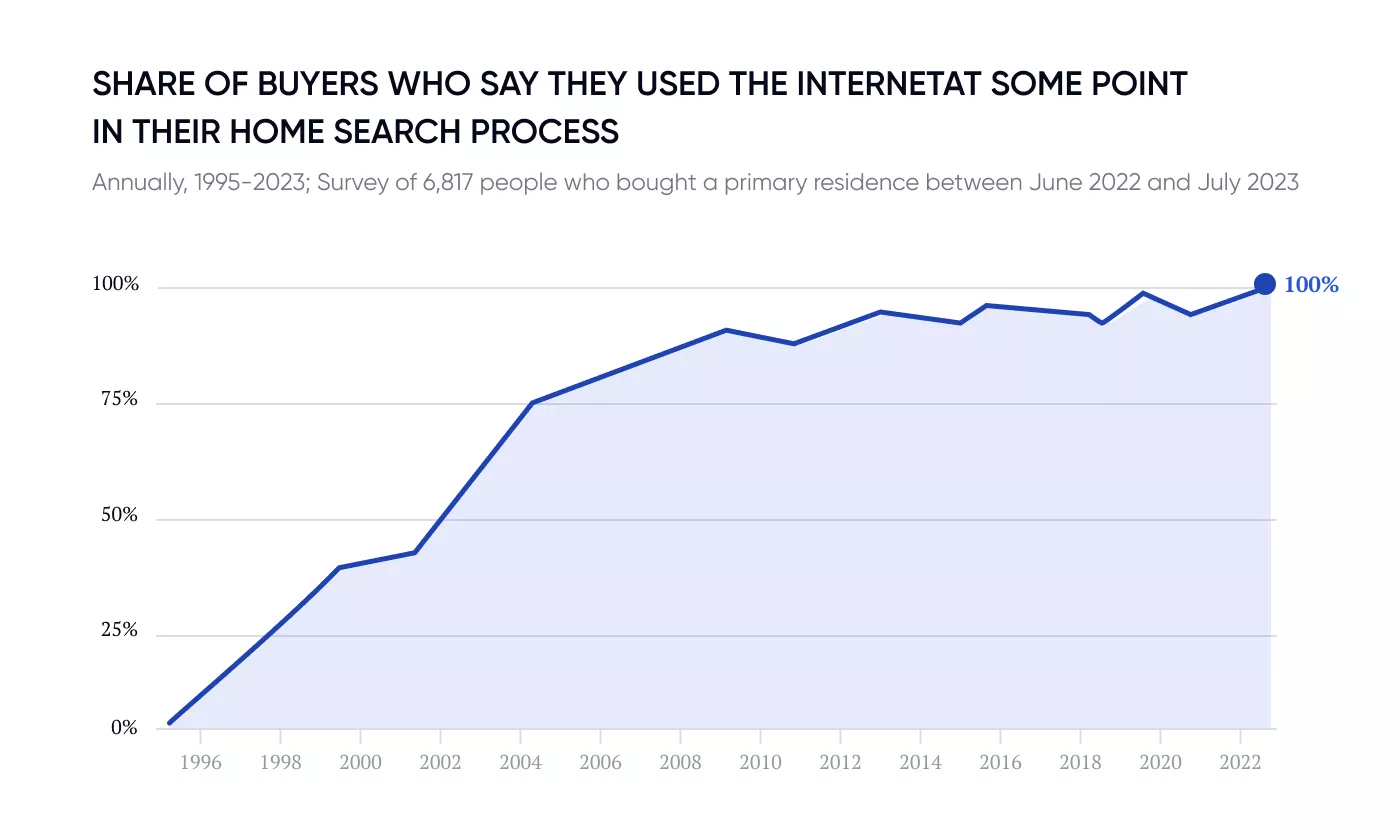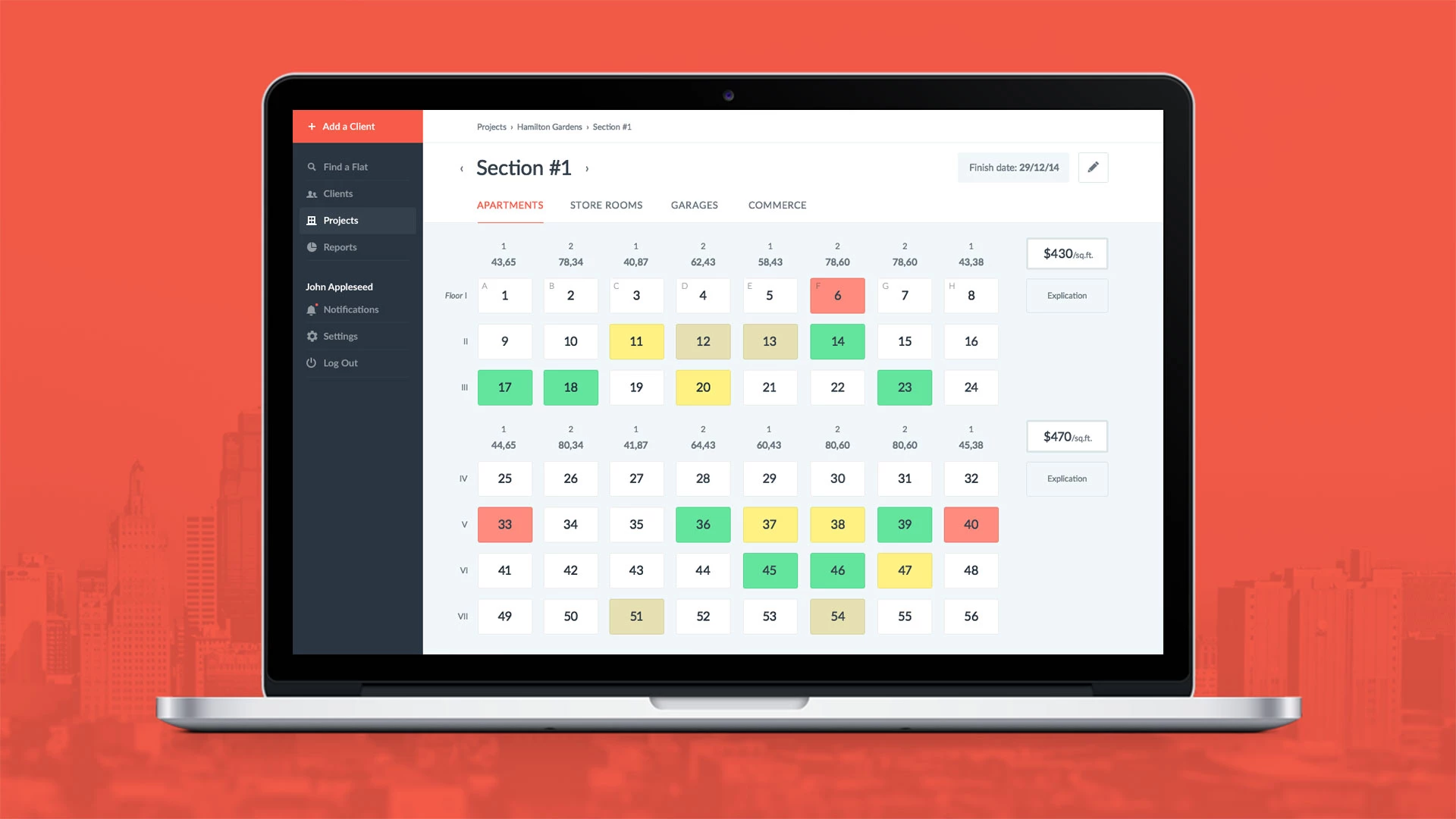
Real estate has always been about location, location, location. But in today's digital age, having an excellent website is just as important for real estate businesses.
100% of homebuyers search online during their home-buying process. Just like a property's curb appeal, your website is the new storefront for your real estate business.

Whether you're a solo agent or boutique brokerage, this guide on how to build a website for real estate will walk you through the key elements to create a high-performance product that drives results. Let's make sure your online presence attracts the right homebuyers and sellers.
Online Real Estate Market Overview
The internet has transformed how people buy and sell homes. More and more transactions now start online. In 2023, 52% of buyers found the home they purchased on the internet. With such a big shift to online, having an effective property website is crucial. Your website is often the first impression buyers get of your business.
Online real estate platforms make it easy to view listing photos, get neighborhood details, and even take virtual tours - all from your couch. Major sites like Zillow and Homes.com attract over 200 million monthly visitors.
Globally, the property market is expected to reach $637.80 trillion by the end of this year. This tremendous market means intense competition for housing portals. Creating a modern, user-friendly site is essential to stand out.
Why Create a Real Estate Website?
The internet is where people look for homes. A well-designed website can be a powerful tool for attracting new clients, showcasing your listings, and establishing your brand. Here are some reasons why you should start website development for real estate.
Increased Visibility and Outreach
With 5.35 billion active internet users worldwide, creating a website expands your reach beyond your local area. Potential buyers and sellers can find you easily through online searches. It gives you a wider audience and more opportunities to connect with clients.
24/7 Accessibility
Unlike traditional brick-and-mortar offices, a website is available around the clock. Your website works hard even when you sleep. This allows clients to browse listings, learn about your services, and contact you at their convenience. This level of accessibility can be a significant advantage in the fast-paced housing market.
Cost-Effective Marketing
Maintaining an online presence through a website is often more cost-effective than traditional marketing methods, such as print advertisements or billboards. With a website, you can showcase your listings and services to a global audience at a fraction of the cost.
Enhanced Credibility
Having an effective property website is crucial, just like in car rental website development, where trust and clarity drive conversions. In the age of information, a professional website lends credibility to your business. Clients are more likely to trust a real estate company with an informative, well-designed website. It reflects their expertise and commitment to providing quality service.
Lead Generation
A website can be an excellent lead-generation tool. You can incorporate property search tools, contact forms, and lead capture mechanisms. Thus, you can gather valuable information about potential clients. Then, it is easier to market to them with the right content.
Analytics and Insights
Most website platforms offer analytics tools that provide valuable insights into user behavior, traffic sources, and engagement metrics. These data-driven insights can help you refine your marketing strategies, optimize your website, and make informed decisions about your business.
Want a web app that does more?
Let's build a solution that's smart, sleek, and powerful.
Alina
Client Manager

How Does a Real Estate Work?
Before moving on to how to create a real estate website, let’s understand how it works. A housing website is an online platform that allows people to search for properties to buy or rent. It is a digital marketplace connecting buyers/renters with sellers/landlords. Let's break down how these sites function.
The Front-end
When you visit a property website, the first thing you see is the front-end. This is the user interface with search filters, listing pages, images, maps, and other tools to aid your property hunt. The design aims to make browsing listings easy and intuitive.
Think of it like walking into a real estate office filled with property brochures. This virtual "office" uses technology to narrow down relevant options quickly based on your search criteria. These can be price range, location, number of bedrooms/bathrooms, and so on.
The Back-end
While the front-end is what users interact with directly, the back-end is the engine powering the website experience. It handles data storage, calculations, search processing, and more running behind the scenes.
Continuing our real estate office analogy, the back-end is like having a highly efficient team managing and updating all the property files as new listings arrive and old ones sell. Except this "team" is software and databases automatically syncing the latest information.
Data Integration
For a home search site to work, it needs a constant feed of property data from various sources. These are listing services, real estate agencies, homeowners, and others. The back-end has systems to receive the data. They process it into a standardized format and integrate it with the search/filtering tools on the front-end.
It's like speaking different languages. The website acts as a translator, converting diverse property listing data into a common language its search tools can understand and match with user queries.
Lead Management
When prospective buyers or renters find a property they're interested in, realty websites aim to capture their information as a "lead" to connect them with a relevant agent or listing party. Tools for communication, scheduling viewings, and application processes are built into the back-end workflow. This is, probably, the most pivotal function. The entire purpose is to facilitate connections between the supply and demand sides of the housing market.
Types of Real Estate Site
Home search sites come in many forms these days. Some help people buy and sell homes. Others assist with renting properties or managing them. Let's explore the main types.
Property Listing Website
These allow agents and brokers to advertise available properties. Buyers can search the listings by criteria like location, price, and number of bedrooms.
A key feature is detailed listing pages. They show all the important property information. That means buyers get in-depth insights before scheduling viewings. Many listing sites also have tools for following new listings or saving favorites.
Property listing sites use many listing services (MLS). These are databases where agents share their listings across the industry. This integration happens through data feeds called IDX (internet data exchange). Examples include Zoopla, Rightmove, and Realtor.com.
Real Estate Marketplaces
Marketplaces connect property buyers and sellers. Think of them as an online meeting place for transactions. Both parties create accounts and post listings or property searches.
On the buyer/renter side, these sites let you search listings, view photos/details, and contact sellers. Examples are Redfin, Trulia, Zillow, and Airbnb for vacation rentals.
By removing the middleman agent, marketplaces reduce transaction costs for both parties. Sellers pay modest listing fees rather than hefty agent commissions.
Many marketplaces offer extra real estate services too. Examples include mortgage calculators, legal advice, inspection scheduling, and more. The aim is to be a one-stop shop for completing the sale.
Real Estate Aggregators
Aggregators gather property listings from various sources into one database. Their strength is a centralized search across the entire housing market. That lets buyers compare a vast number of options with ease.
Most get rental listings from property managers and owners. They also pull in many sale listings from other realty sites. Most leverage a combination of MLS data feeds, listing site partnerships, direct uploads, and more to amass a wide pool of properties for sale and rent. Detailed filters help narrow down relevant matches. Examples of leading aggregators that pull from many sources are Nestoria and Home.co.uk.
Property Management Sites
As the name implies, these sites assist landlords and property managers with overseeing their rental portfolios. Core features include marketing available rentals and screening tenants. Add to this collecting rent payments, tracking leases, and managing maintenance requests.
There are also extra capabilities like accounting, reporting, insurance tracking, and more. This allows landlords to run their rental businesses through a comprehensive online platform. Examples are Appfolio, Rentec Direct, and Yardi.
Renting Websites
Similar to property management sites, these focus on connecting renters with landlords or property managers. Yet, the main users are people seeking rental housing rather than landlords.
On the landlord side, full-fledged renting platforms like Trulia and Rentals.com often bundle tenant screening, e-leasing, payment processing, and property management capabilities. Some focus on a certain rental niche, like short-term/"vacation" rentals (e.g. Vrbo) or long-term/permanent housing. Yet, most span both short- and long-term rental types.
Tech Trends in Real Estate Website Development
Leading trends include AR and VR property tours, AI and ML, Big Data, and IoT.
Augmented Reality (AR)
AR enables immersive 3D virtual property tours. Home buyers can virtually "walk through" listings from their devices. AR provides a highly realistic viewing experience.
Virtual Reality (VR)
VR offers an even more immersive 3D experience than AR. Prospects can "step inside" properties using VR headsets or 360 videos.
Big Data
The industry generates massive amounts of data on properties, transactions, demographics, etc. Harnessing big data allows better analytics for pricing strategies, targeting marketing, and identifying hot areas.
AI and Machine Learning
AI and ML can analyze large datasets to discover patterns and insights humans may miss. Applications include automated property valuation models and predictive analytics.
Internet of Things (IoT)
IoT devices like smart home systems, security cameras, appliances etc. are becoming standard in properties. The Internet of Things (IoT) may enable a prospective homebuyer to access comprehensive records of a property's maintenance and upkeep. This could negate the need for costly home inspection fees.
Want to learn more about the hottest housing tech trends this year? Read our article "8 Hottest Real Estate Technology Trends in 2024" for an in-depth look at innovative technologies transforming the industry.
How to Build a Real Estate Website: 6 Steps
Building a realty site can be a game-changer for your business. It allows you to showcase your listings, connect with potential clients, and streamline your operations. Here's a step-by-step guide on how to make a real estate website to help you get started.
Market Research
The first step is to understand your target audience. Who are your clients? What are their needs and pain points? Conduct market research to gather insights that will shape your website's content and functionality.
Choose a Real Estate Site Type to Develop
Decide on the type of the website you want to build. Will it be a listing platform, a property management tool, or a real estate aggregator? This decision will guide your development process.
UI | UX Design
Invest time in crafting an intuitive and visually appealing user interface and user experience. Your website should be easy to navigate and provide a seamless experience for your visitors. Development
Bring your website to life by developing the back-end and front-end. Choose the right tech stack, ensure data security, and optimize the website for speed and performance. Popular options include WordPress, Drupal, or custom-built solutions using frameworks like Ruby on Rails or Django.
Develop the MVP
Start with a minimum viable product (MVP) to test your concept and gather feedback. This will help you refine your website and add the most valuable features.
Launch, Test & Improve
Register your real estate domain. Launch your website, monitor its performance, and continuously refine it based on user feedback and analytics. Regularly update your content, optimize for search engines, and adapt to market changes.
The Must-Have Features of a Real Estate Website
Here are the key features your site needs.
Registration
Let buyers create accounts to save favorite listings and searches. Registration also enables lead tracking and personalized email updates on matching properties.
Search Filters
Provide robust search capabilities to streamline the hunting process. Common filters include location, price range, number of bedrooms/bathrooms, square footage, and amenities. Advanced options like keywords, drawn map areas, and commute times facilitate exactly specifying needs.
Map Features
An interactive map displaying listings is essential for visualizing options within desired areas. Markers denoting properties, neighborhood boundaries, points of interest, and transportation provide helpful location context.
Property Visualization
People today expect a seamless online experience. 89% of buyers say they were more interested in viewing properties with listing details, photos, videos, and virtual tours online. Virtual tours recreating the experience of an in-person walkthrough are a powerful selling tool. Detailed floor plans, 3D walkthroughs, and drone footage differentiate premium listings.
How To Make Money on Real Estate Sites?
Building a successful housing website takes work, but there are several ways to monetize it and turn it into a money-maker. Here are four common monetization models to consider:
Advertising
One of the most straightforward ways to generate income is through advertising. You can sign up for Google AdSense to display ads on your site and get paid when users click on them. You can also sell ad space directly to relevant businesses like real estate agents, mortgage brokers, and banks. Charge advertisers based on factors like zip code, cost-per-click, or cost-per-lead.
Freemium Model
With this approach, basic features are free, but you charge for premium tools and services. Free users get limited access, while paid subscribers unlock advanced search filters, premium listings, analytics, and more valuable capabilities. The key is offering enough free value to attract a wide user base, you can then upsell to premium.
Subscription Packages
Similar to freemium but more all-inclusive. You create different pricing tiers that give access to your platform data, tools, and services. Offer monthly or annual subscriptions customized for different user types, like buyers, sellers, agents, etc.
Commission Fees
Though less common, you could take a cut of transactions facilitated through your real estate marketplace. To do this, you'll need to find a trusted payment processor and decide what percentage commission to charge on completed deals.
How Much Does it Cost to Build a Real Estate Website?
Expect to pay $80,000+ for a modern, responsive housing website. Costs depend on the developer's rates and the site's features.
Key factors that impact cost:
- Number of pages and listings
- Custom design vs template
- Integrated MLS/IDX feeds
- Agent/community pages
- Lead capture forms
- Hosting and maintenance
Don't forget the ongoing expenses like hosting, domain renewal, and maintenance. Budget 5% to 10% of the initial cost per year, depending on your needs.
Conclusion
A powerful website can help you generate more leads, build your brand reputation, and streamline your operations. However, with so many realty sites out there, crafting a site that truly stands out from the competition is no easy feat. It requires strategic planning, engaging design, and robust functionality tailored to the unique needs of the housing industry. Building a site with all the features and functionality your business needs can be a complex undertaking.
That's where the experts at Stfalcon come in. Our dedicated team has extensive experience crafting powerful housing solutions tailored to each client's unique requirements.
For example, our team developed a user-friendly property management platform that seamlessly integrates with Airbnb's API for efficient data synchronization across numerous listings.
In another project, Stfalcon built a sophisticated CRM system to automate sales processes, preserve customer history, match properties to buyer interests, and streamline contract management.
With our proven track record and industry know-how, Stfalcon has the skills to bring your vision to life. Take the first step towards an exceptional online presence and contact us today.
Below, find answers to popular questions about how to create a website for real estate.
FAQs about Creating a Real Estate Website
What is a real estate website?
A real estate site showcases property listings, provides information about the company and its services, and helps generate leads from potential buyers or sellers.
How long does it take to develop a custom real estate site?
The development timeline can vary depending on the site's complexity and features. A basic website may take 2-4 months. More advanced sites with custom functionality could take more than 6 months.
How much does it cost to develop a real estate website?
Costs are different for basic sites and fully custom solutions, expect to start from around $80,000. Key factors like design, listings integration, and included features impact the total price. Ongoing hosting and maintenance add extra annual expenses.

 Read the full case study
Read the full case study
 Read the full case study
Read the full case study


